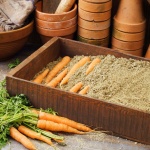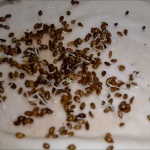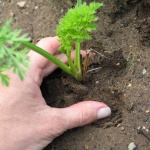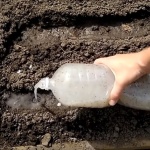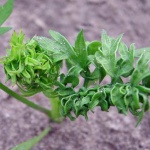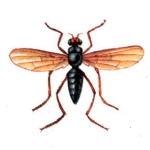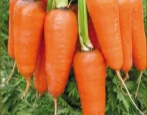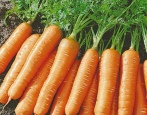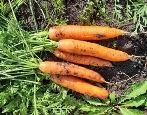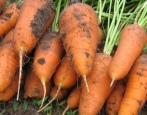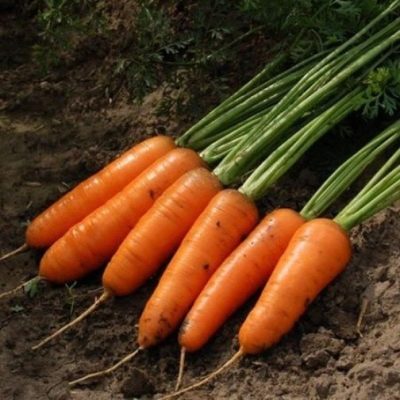
- Year of approval: 2006
- Appointment: for fresh consumption, for making juice
- Leaf rosette shape: semi-spreading
- Leaves: long, green, coarsely dissected
- Weight, g: 110-215
- The form : fusiform with pointed tip
- Taste qualities: good and excellent
- Composition : dry matter 11.9-15.4%, total sugar 7.6-9.4%, carotene up to 16.5 mg per 100 g of raw matter
- Ripening terms: late ripening
- Growing regions: Central, North-West, TsChO, Volgo-Vyatka, Nizhnevolzhsky, West Siberian, Far Eastern, North Caucasian, Ural, East Siberian
Carrots are grown in almost every garden bed. When choosing a variety for planting, many gardeners give preference to hybrids, since they are not capricious in care, give high and stable yields, and are also resistant to viruses. These varieties include the mid-late hybrid Cascade.
Breeding history
Carrot Cascade is a first generation hybrid developed by a group of scientists from the Dutch company Bejo Zaden B. V. in 2001. After the tests carried out, the vegetable crop was entered in 2006 into the State Register of approved for use in the Central Region. Today, the vegetable is massively grown in different regions of Russia. Carrots are cultivated in garden ridges, in the fields.
Description of the variety
The Dutch hybrid is characterized by a powerful upright rosette with a semi-spreading structure. The leaves of the tops are rather long, emerald green, with coarsely split edges. It is worth noting the absence of a sharp aroma in the tops, as well as high resistance to shooting (flowering). During growth and development, the root crop is well submerged in the soil, which facilitates the harvesting process. Cascade belongs to the Chantenay variety.
Characteristics of the appearance of the plant and root crops
The cascade is a medium-fruited variety. On average, a vegetable gains a mass of 110-120 grams, but sometimes it grows up to 215 grams. The shape of the vegetable is unusual - fusiform with a pointed tip. The hybrid is shortened - the length of the carrot does not exceed 18-20 cm, and the diameter is 3-5 cm. The ripe root crop is evenly covered with a rich orange color. The vegetable skin is smooth and shiny, without cracks or bumps.
The excavated crop is easy to transport and also has a long shelf life. In a cool and dry place, carrots can be stored until spring.
Purpose and taste of tubers
The cascade is famous for its great taste. The orange flesh is firm and crispy. Endowed with a fleshy and very juicy structure without voids and fiber. The taste is dominated by bright sweetness, pleasant sugariness, complemented by the classic carrot aroma. The core of the root crop is thin.
A huge advantage of the fruit is the pulp, in which the increased content of carotene, sugars, potassium, calcium, phosphorus, iron, magnesium, as well as vitamins of group B, PP, K, C, E.
The harvested root vegetables are added to hot and cold dishes, pickled, used in canning vegetables, eaten fresh, and also cultivated as a preparation for the winter. In addition, Cascade carrots are ideal for processing into juice, as well as for the production of baby and dietetic food.
Maturation
The Dutch root crop belongs to the late maturing species. The growing season lasts 120-130 days. Harvesting can begin in July.The longer the carrots are in the ground, the larger they will be. The massive harvest falls in August-September, and if the weather permits, then until mid-October.
Yield
The yield indicators of the hybrid are always pleasing, regardless of weather conditions. On average, up to 7 kg of leveled root crops can be dug / pulled out from 1 m2, and on an industrial scale, you can count on 250-390 c / ha.
Growing and caring
Carrots are grown by seed method. To do this, long grooves with a depth of 1-2 cm are prepared in the prepared area. The distance between the rows should be at least 15 cm, and sowing is carried out according to the 20x5 cm scheme. It is recommended to plant the vegetable during the period when the air and soil are warmed up to + 6 ... 8 degrees. The best time is from April 20 to May 10. Good precursors for carrots are courgettes, cucumbers, cabbage, garlic, and onions.
Caring for a vegetable consists of standard procedures: weekly watering with settled water, fertilizing 2 times per season (the culture prefers liquid fertilizing), loosening and weeding the soil, thinning (twice during the growing season), keeping a distance of up to 4 cm, as well as preventing viruses.
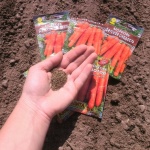
Carrots are one of the most unpretentious crops in terms of growing conditions; they can endure a short drought and a short cold snap. However, to get tasty and large root crops, you should adhere to the basic rules for planting carrots.
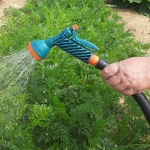

Soil requirements
The most comfortable for the hybrid Cascade is loose, nutritious and breathable soil with neutral acidity. Planting in fertile loam with good drainage is generally recommended.
Required climatic conditions
The hybrid is planted in sunny areas where there is enough heat and light, and there is also no cold wind and stagnant water.
Disease and pest resistance
The immunity of the hybrid is average, providing tolerance to many diseases - bacteriosis, septoria, phomosis, gray and white rot. A vegetable can be attacked by a carrot fly and a winter scoop.
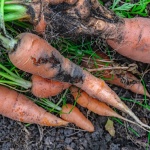
Carrots grow in almost any garden. There is an opinion that this culture is very resistant to all kinds of diseases and pests, but this is not the case. Without proper care, carrots become susceptible to all kinds of infections and are affected by harmful insects.

